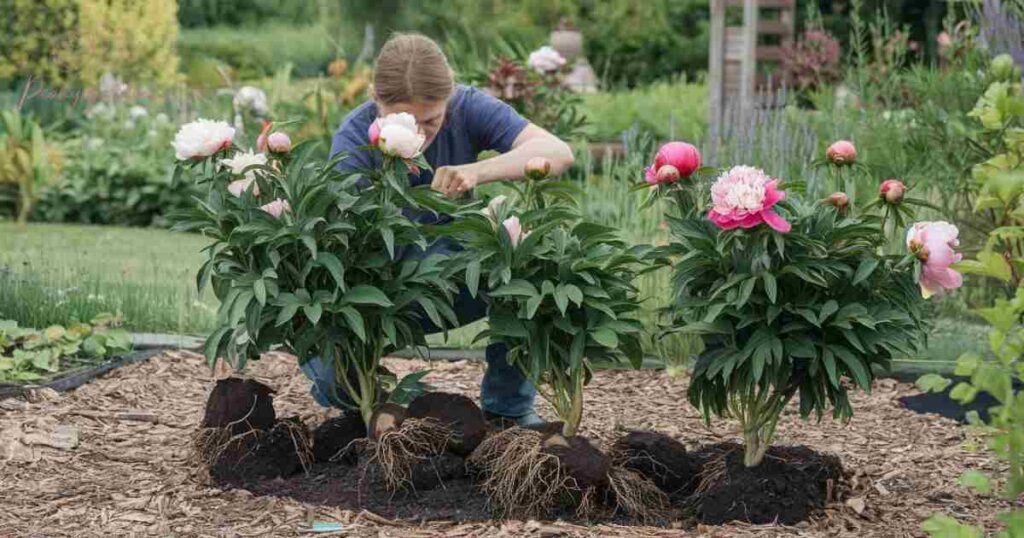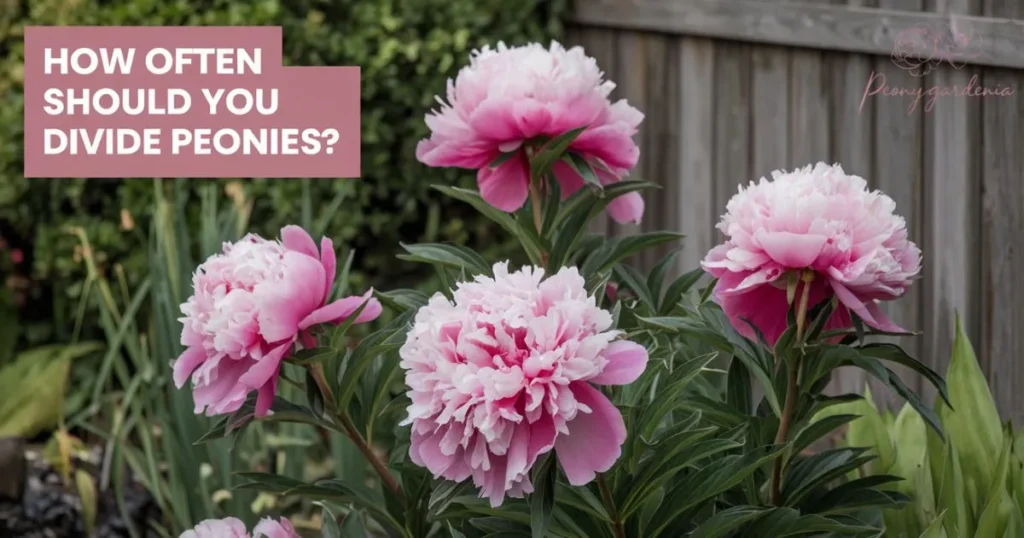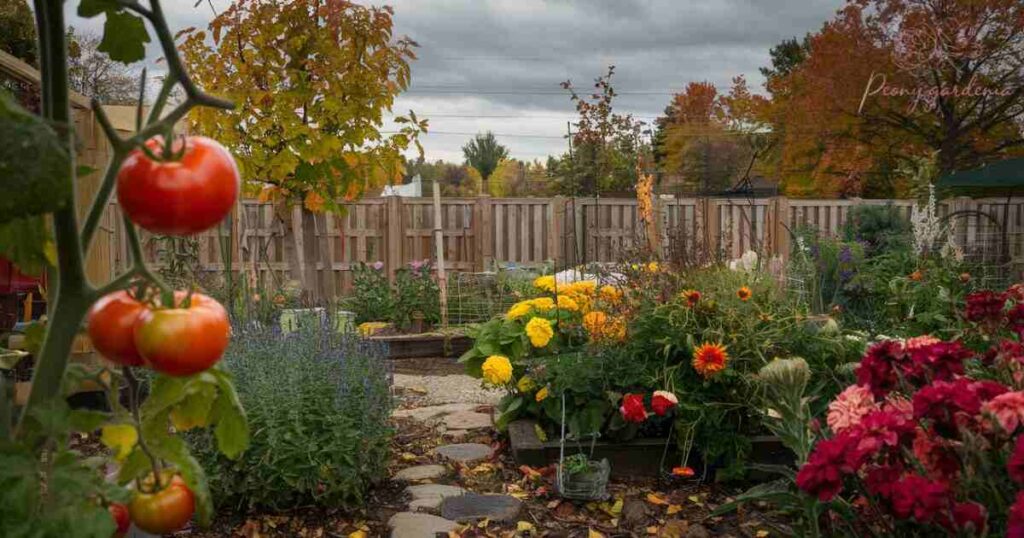Divide peonies is the process of separating a mature peony plant into smaller sections. This helps promote healthier growth and more blooms. It’s best done in early fall, after the plant has finished blooming. Each divided section should have roots and buds to grow into a new plant.
Dividing peonies helps them grow stronger and bloom better. It’s a simple process that can refresh old plants. The best time to divide peonies is in early fall. With a little care, your peonies will thrive and produce beautiful flowers year after year.
To divide peonies, wait until early fall when the plant has finished blooming. Carefully dig up the root clump and separate it into smaller sections. Make sure each section has roots and buds. Replant the divisions in well-drained soil, and water them well to help them establish.
Understanding Why Peonies Need Dividing
Peonies are known for their lush blooms and long lifespan, but to keep them thriving, it’s important to understand why you may need to divide peonies. Over time, peony plants can become overcrowded, leading to reduced flower production and weaker growth.
Dividing peonies helps rejuvenate the plant, ensuring it continues to produce vibrant blooms year after year. Additionally, dividing offers an opportunity to propagate peonies, creating new plants for your garden or sharing with others. The best time to divide peonies is when they enter dormancy, typically in early fall, ensuring minimal stress and a successful transition for the plants.
Read more: Do peonies bloom all summer?
How to Divide Peonies

Now that your plant is ready, follow these steps to divide it successfully:
Step 1: Dig Up the Peony
When it’s time to divide peonies, the first step is to carefully dig up the plant. Using a spade or shovel, loosen the soil around the peony, taking care not to damage the roots. Once the soil is loose, gently lift the entire plant out of the ground. It’s essential to avoid disturbing the root system too much to prevent stress on the plant.
After digging up the peony, carefully separate the roots into smaller sections, each with at least one healthy bud. This process of dividing peonies helps rejuvenate the plant, promoting better blooms in the future.
- Use a garden spade or fork to dig around the plant, starting 12–18 inches from the base to avoid damaging the roots.
- Gently lift the root ball from the ground, shaking off excess soil to expose the roots.
Step 2: Inspect the Roots
Before you divide peonies, it’s essential to inspect the roots carefully. Healthy roots are crucial for successful replanting, as damaged or diseased roots can hinder the plant’s recovery. Gently lift the peony clump from the ground, taking care not to break the roots.
Look for thick, white, or light-colored roots, as these indicate vitality. If you notice any black, mushy, or rotting roots, trim them off with a clean, sharp tool. This inspection ensures that when you divide peonies, each section will have strong roots to support future growth and bloom, giving the plant the best chance for success.
Step 3: Divide the Roots
To successfully divide peonies, it’s crucial to focus on properly dividing the roots. Start by carefully digging around the plant to expose the root clump. Gently lift the roots from the soil, ensuring you don’t damage them.
Use a sharp, sterile knife or pruning shears to divide the roots into sections, each containing at least three to five eyes (buds). Make sure each divided section has a healthy portion of roots to encourage strong regrowth. After dividing peonies, replant the sections immediately to avoid stress and allow them to establish in their new location for a thriving bloom next season.
Step 4: Prepare the New Site
Before you divide peonies, it’s essential to prepare the new site where the plants will be relocated. Choose a location that offers full sunlight and well-draining soil, as peonies thrive in these conditions. Begin by digging a hole that’s wide enough to accommodate the divided root clumps, allowing for proper spread and growth.
Incorporate compost or organic matter into the soil to improve fertility and drainage. Make sure the new site is not prone to waterlogging, as peonies dislike wet feet. Proper preparation will ensure your divided peonies establish themselves well and continue to flourish in their new location.
Step 5: Replant the Divisions
After you divide peonies, it’s crucial to replant the divisions promptly to ensure they establish strong roots. Choose a location with well-draining soil and plenty of sunlight, as peonies thrive in these conditions. Dig a hole that’s deep enough to accommodate the roots without crowding them.
Position the peony division with the eyes (buds) facing upward, ensuring they are planted at the same depth as they were in their previous location. Water the newly planted divisions thoroughly and apply mulch to retain moisture. Proper care after you divide peonies will promote healthy growth and vibrant blooms in the future.
Step 6: Water and Mulch
When you divide peonies, proper watering and mulching are crucial to ensure the plants thrive after the process. After dividing peonies, water the roots thoroughly to help them settle in and encourage new growth. Peonies prefer consistently moist soil, but avoid waterlogging, as it can lead to root rot.
Mulching around the plants with organic material, such as straw or wood chips, helps retain moisture and suppress weeds. A 2-3 inch layer of mulch also insulates the soil, keeping it cool in summer and protecting the roots in winter. These practices are essential for healthy, vigorous peony plants post-division.
The Best Time of Year to Divide Peonies

The best time of year to divide peonies is in late summer or early fall, typically from late August to early September. During this period, the plants enter dormancy, making it less stressful for them to undergo division and replanting. Cooler temperatures and consistent soil moisture provide an ideal environment for the roots to establish before winter. Dividing peonies during this time ensures they have enough energy stored in their roots to thrive in the upcoming growing season. Properly timing the process is crucial to encourage healthy blooms and prevent transplant shock. Always handle and divide peonies carefully to avoid damage.
Signs That Your Peonies Need Dividing
Knowing when to divide peonies is essential to maintain their health and vibrant blooms. Look for these signs that indicate it’s time to divide your plants:
- Reduced Flowering: Your peonies produce fewer blooms than usual, or the flowers are smaller and less vibrant.
- Crowded Growth: The plant’s center appears crowded or bare, with most growth concentrated on the edges.
- Poor Plant Health: Leaves turn yellow or show signs of disease due to overcrowded roots.
- Root Overgrowth: Roots become tangled or rise above the soil.
- Decline in Vigor: The plant looks weak or struggles to thrive despite proper care.
How Often Should You Divide Peonies?

Peonies are long-lived perennials that generally don’t need to be divided frequently. It’s best to divide peonies every 4 to 6 years, although some plants may thrive for even longer before showing signs of overcrowding.
Dividing peonies too often can stress the plant and affect blooming. When the flowers start to decline in size or the plants become too crowded, it’s a good indication that it’s time to divide peonies. The ideal time for division is in early fall or late summer when the plant is not in full bloom, allowing the roots to establish in the cooler months.
How to Prepare Peonies for Division
Preparing peonies for division is essential for a successful transplant. Follow these steps:
- Choose the Right Time: The best time to divide peonies is in early fall, after the blooms have faded.
- Cut Back Foliage: Trim the plant back to about 4-6 inches above the soil to make it easier to work with.
- Water Well: Ensure the plant has received enough water in the days leading up to division.
- Loosen the Soil: Use a spade or fork to gently loosen the soil around the plant, being careful not to damage the roots.
- Dig Up the Root Clump: Carefully lift the entire peony root clump from the soil for division.
Late Summer vs. Early Fall: When Is Better?

When deciding the best time to divide peonies, both late summer and early fall have their advantages. Dividing peonies in late summer, after they’ve finished blooming, can give the plant a head start before the colder months, allowing the roots to establish in the soil. However, early fall is often considered the optimal time to divide peonies.
During this period, the plants are entering dormancy, reducing the stress of transplanting. Dividing peonies in early fall ensures they have enough time to recover and develop healthy roots before the winter, setting them up for strong growth in the spring.
Conclusion
In conclusion, knowing when to divide peonies is key to maintaining healthy and vibrant plants. The ideal time to divide peonies is in early fall, once the blooming season is over, allowing the plants to recover and establish roots before winter. Signs such as overcrowding, reduced blooms, or poor growth indicate it’s time when to divide peonies.
Proper care, including watering, mulching, and choosing the right time for division, will ensure successful transplantation. By following these steps, your peonies will continue to thrive, offering beautiful blooms for years to come. Dividing peonies can revitalize their growth and longevity.
FAQs
When is the best time to divide peonies?
The best time to divide peonies is in early fall, after the blooms have faded.
How often should you divide peonies?
Peonies should be divided every 4-6 years or when they become overcrowded.
Can I divide peonies in spring?
It’s not recommended to divide peonies in spring as it may disrupt their growth cycle.
What signs indicate it’s time to divide peonies?
Signs include overcrowded roots, fewer blooms, or poor growth.
How do I care for divided peonies?
Care for divided peonies by watering them well and applying mulch to retain moisture.









